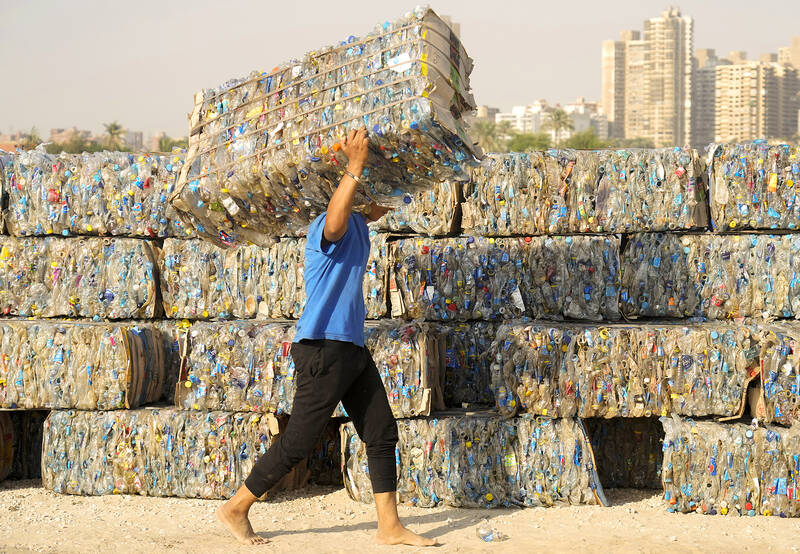Colgate-Palmolive Co spent years devising a recyclable toothpaste tube. Pulling it off was a technical masterstroke, substituting plastic for a mix of materials that was historically tough to reclaim. The result was “nice squeezability,” one executive said.
One big problem remains: Many sorting centers in the US and elsewhere do not accept them.
The gap between Colgate’s engineering success and the practicalities of where-do-we-toss-our-empties underscores a persistent challenge for the corporate US: Switching to packaging that can bypass landfills is not enough if there is no easy way to recycle it. In Colgate’s case, that is 9 billion tubes a year requiring extra effort to avoid the trash heap.

Photo: AP
The new tubes, which cover 78 percent of the company’s US toothpaste lineup, are made with high-density polyethylene (HDPE), the recyclable plastic used for products such as milk jugs.
In the fragmented US system, however, companies making recyclable products have to persuade a wide range of stakeholders, from local governments to private companies, to accept the items, sort them and turn them into something new. It is a process that can take years. The tubes are still not classified as recyclable by How2Recycle, an organization that issues standardized labels with instructions on how to dispose of packaging.
Goods eligible for collection vary by community, and an estimated 40 million US households do not have access to recycling services from their homes. This all means that plastics get reclaimed at rates of only 8 to 28 percent, depending on the type.

Photo: Bloomberg
In light of the challenge, Colgate said it has engaged players across the supply chain for years. It has also shared its new tube design with other companies, and said competitors would adopt similar recyclable plastic tubes by 2025.
“It is not easy work, given the many aspects of the process, but we are committed, and we believe we are on the right path,” Colgate said.
The company has pledged to shrink its plastic waste and use “100 percent recyclable, reusable or compostable plastic packaging by 2025,” it said.
Sarah Dearman, chief innovation officer at the Recycling Partnership, an industry-funded group working to improve the system, said the new tubes are “a great step.”
However, consumers must also have access to collection systems that accept the tube.
It is not clear how many do, nationwide assessment by the Sustainable Packaging Coalition, an industry working group said.
Colgate said the tube has a third-party certification showing it can be processed alongside HDPE bottles, which 87 percent of Americans can put in recycling bins.
That type of plastic ends up being recycled nearly 30 percent of the time, one of the highest rates among recyclable materials in the US.
However, Colgate said that acceptance might still be limited and advised consumers to check with local community programs.
The company started updating the artwork on its boxes to provide more information.
Some consumers are taking note.
Ethan Helvering, a tech worker living in Los Angeles, said he was looking for sustainable toothpaste alternatives when he stumbled upon Colgate’s new tube. He sees recyclability as a selling point and is glad to see the company’s efforts, although he has questions about what ultimately happens.
“If there’s an option to put something in the recycling, I’ll do it,” Helvering said. “Hopefully processes improve and at some point it becomes an actual reality.”
Colgate’s new tubes usually get sorted to the correct group once they reach plants that recover materials and bundle similar plastics together, a test commissioned by the company showed.
However, most US recovery facilities do not take tubes because the recyclable and traditional versions are so similar, said Sandeep Kulkarni, a technical consultant at the Association of Plastic Recyclers, a trade group.
The old tubes could cause contamination if consumers put them in the recycling bin, so it is still easier for recycling facilities to reject toothpaste tubes across the board, he said.
Waste Management Inc, which offers recycling and disposal services, said the tubes are not in its list of acceptable items.
Another concern is leftover toothpaste causing contamination, said Pete Keller, an executive at waste disposal company Republic Services Inc.
It is another area that seems to have discrepancies: On its Web site, Colgate says any residual toothpaste in the tubes is removed during the rinsing process at recycling facilities.
Together, Waste Management and Republic Services run about one-quarter of US materials-recovery facilities tracked by the Recycling Partnership, which said processing capacity is also an important factor.
Sander Defruyt, who leads a plastics-reduction initiative at the Ellen MacArthur Foundation, said that given the challenges of recycling, companies should invest more in alternatives such as reusable containers and packaging.

GROWING OWINGS: While Luxembourg and China swapped the top three spots, the US continued to be the largest exposure for Taiwan for the 41st consecutive quarter The US remained the largest debtor nation to Taiwan’s banking sector for the 41st consecutive quarter at the end of September, after local banks’ exposure to the US market rose more than 2 percent from three months earlier, the central bank said. Exposure to the US increased to US$198.896 billion, up US$4.026 billion, or 2.07 percent, from US$194.87 billion in the previous quarter, data released by the central bank showed on Friday. Of the increase, about US$1.4 billion came from banks’ investments in securitized products and interbank loans in the US, while another US$2.6 billion stemmed from trust assets, including mutual funds,

AI TALENT: No financial details were released about the deal, in which top Groq executives, including its CEO, would join Nvidia to help advance the technology Nvidia Corp has agreed to a licensing deal with artificial intelligence (AI) start-up Groq, furthering its investments in companies connected to the AI boom and gaining the right to add a new type of technology to its products. The world’s largest publicly traded company has paid for the right to use Groq’s technology and is to integrate its chip design into future products. Some of the start-up’s executives are leaving to join Nvidia to help with that effort, the companies said. Groq would continue as an independent company with a new chief executive, it said on Wednesday in a post on its Web

JOINT EFFORTS: MediaTek would partner with Denso to develop custom chips to support the car-part specialist company’s driver-assist systems in an expanding market MediaTek Inc (聯發科), the world’s largest mobile phone chip designer, yesterday said it is working closely with Japan’s Denso Corp to build a custom automotive system-on-chip (SoC) solution tailored for advanced driver-assistance systems and cockpit systems, adding another customer to its new application-specific IC (ASIC) business. This effort merges Denso’s automotive-grade safety expertise and deep vehicle integration with MediaTek’s technologies cultivated through the development of Media- Tek’s Dimensity AX, leveraging efficient, high-performance SoCs and artificial intelligence (AI) capabilities to offer a scalable, production-ready platform for next-generation driver assistance, the company said in a statement yesterday. “Through this collaboration, we are bringing two

Even as the US is embarked on a bitter rivalry with China over the deployment of artificial intelligence (AI), Chinese technology is quietly making inroads into the US market. Despite considerable geopolitical tensions, Chinese open-source AI models are winning over a growing number of programmers and companies in the US. These are different from the closed generative AI models that have become household names — ChatGPT-maker OpenAI or Google’s Gemini — whose inner workings are fiercely protected. In contrast, “open” models offered by many Chinese rivals, from Alibaba (阿里巴巴) to DeepSeek (深度求索), allow programmers to customize parts of the software to suit their